
SS Europa, later SS Liberté, IMO 5607332, was a German ocean liner built for the Norddeutsche Lloyd line (NDL) to work the transatlantic sea route. She and her sister ship, Bremen, were the two most advanced, high-speed steam turbine ocean vessels in their day, with both earning the Blue Riband.

USS Susquehanna (ID-3016) was a transport for the United States Navy during World War I. She was the second U.S. Navy ship to be named for the Susquehanna River. Before the war she operated at SS Rhein, an ocean liner for North German Lloyd. She was the lead ship of her class of three ocean liners. After the end of World War I, the ship operated briefly in passenger service as SS Susquehanna. Laid up in 1922, Susquehanna was sold to Japanese ship breakers in 1928 and scrapped.

USS Freedom (ID-3024) was a cargo and transport ship in the United States Navy during World War I. Originally SS Wittekind for the North German Lloyd line, the ship also served as USAT Iroquois and USAT Freedom after being seized by the United States in 1917.

USS Pocahontas (SP-3044) was a transport ship for the United States Navy during World War I. She was originally SS Prinzess Irene, a Barbarossa-class ocean liner built in 1899 by AG Vulcan Stettin of Stettin, Germany, for the North German Lloyd line.

SS Leviathan was launched on 3 April 1913 and began service in 1914 as the German liner Vaterland (Fatherland) for Germany's Hamburg America Line to be used on its transatlantic passenger service. The ship, second of three running mates and then the largest passenger ship in the world, made its first voyage to New York arriving on 21 May 1914 under the command of a Commodore and four Captains of the German Naval Reserve to celebrations featuring German and American officials at the line's Hoboken facilities. The ship was designed to carry 4,050 passengers with most in third or fourth class. Those among the 700 first class and 600 second class passengers traveled in considerable luxury. The main public rooms took advantage of an unusual arrangement of the routing from boiler to stack along the sides rather than center to feature long and unbroken access from a replica of the New York Ritz-Carlton Restaurant main dining room forward to the lounge and ball room aft. Vaterland served on the route for less than a year before being laid up at the line's piers in the neutral United States due to the start of World War I and risk of seizure by the Allies at sea.

USS Lejeune (AP-74) was a German cargo liner that was converted to a US Navy troop transport during the Second World War. Her original name was TS Windhuk.

SS Kronprinzessin Cecilie was an ocean liner built in Stettin, Germany, in 1906 for North German Lloyd that had the largest steam reciprocating machinery ever fitted to a ship. The last of four ships of the Kaiser class, she was also the last German ship to have been built with four funnels. She was engaged in transatlantic service between her homeport of Bremen and New York until the outbreak of World War I.

SS Cleveland was a German transatlantic ocean liner that was launched in 1908 and scrapped in 1933. Cleveland was built for the Hamburg America Line (HAPAG) as a sister ship for Cincinnati.
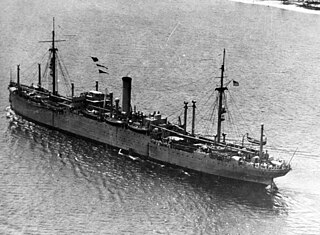
USS Rappahannock (AF-6) was a Rappahannock-class stores ship acquired by the U.S. Navy for use in World War I. She served in the dangerous North Atlantic Ocean, delivering animals, such as horses and steers on-the-hoof, to American Expeditionary Force troops in Europe.
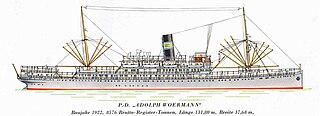
SS Adolph Woermann was a German steam ocean liner built in 1922 by Blohm & Voss in Hamburg for the shipping lines Woermann-Linie (WL) and German East Africa Line and named after German merchant, ship owner and politician Adolph Woermann, and the fourth ship of the same name.
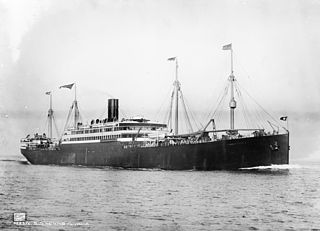
SS Pennsylvania was a was a transatlantic liner that was launched in Ireland in 1896 and spent most of her career with Hamburg America Line (HAPAG). She was the first of a class of four HAPAG sister ships that were built in the United Kingdom and Germany between 1896 and 1899.

USS Aeolus (ID-3005), sometimes also spelled Æolus, was a United States Navy transport ship during World War I. She was formerly the North German Lloyd liner SS Grosser Kurfürst, also spelled Großer Kurfürst, launched in 1899 that sailed regularly between Bremen and New York. At the outset of World War I the ship was interned by the United States and, when the U.S. entered the conflict in 1917, was seized and converted to a troop transport.

SS Friedrich der Grosse was a Norddeutscher Lloyd liner built in 1896 which sailed Atlantic routes from Germany and sometimes Italy to the United States and on the post run to Australia. At the outset of World War I the ship was interned by the U.S. and, when that country entered the conflict in 1917, was seized and converted to a troop transport, becoming USS Huron (ID-1408).

USS Antigone (ID-3007) was a transport for the United States Navy during World War I, and the first ship of that name for the U.S. Navy. She was originally SS Neckar for North German Lloyd from her 1900 launch until seized by the U.S. in 1917. After her war service she was SS Potomac for United States Lines.

The SS König Albert was a German Barbarossa class ocean liner owned by the Norddeutscher Lloyd Line. Interned in Italy at the outbreak of World War I, she was seized by the Italian Government in 1915 and converted to a hospital ship. Sold into merchant service in 1920, she was used as a transport for the Italian Navy, before being scrapped in 1926.

USS Matsonia (ID-1589) was a transport for the United States Navy during World War I. Before and after her Navy service she was ocean liner SS Matsonia for the Matson Navigation Company. The liner was sold in 1937 to the Alaska Packers Association and renamed SS Etolin. Shortly before World War II, the ship was chartered by the United States Army as USAT Etolin. Transferred to the War Shipping Administration in 1946, Etolin was placed in the James River Reserve Fleet and ultimately scrapped in 1957.
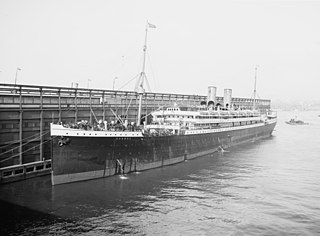
The Barbarossa class was a class of ocean liners of North German Lloyd and the Hamburg America Line of the German Empire. Of the ten ships built between 1896 and 1902, six were built by AG Vulcan Stettin, three were built by Blohm & Voss, and one was built by Schichau-Werke; all were built in Germany. They averaged 11,000 gross register tons (GRT) and featured twin screw propellers driven by quadruple-expansion steam engines.
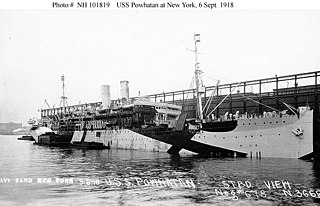
USS Powhatan (ID–3013) was a transport ship for the United States Navy during World War I. She was originally the SS Hamburg, a Barbarossa-class ocean liner built in 1899 by Aktiengesellschaft Vulkan of Stettin, Germany, for the Hamburg America Line. At the outset of World War I the ship was interned by the United States.

SS Königin Luise was a Barbarossa-class ocean liner built in 1896 by Vulcan Shipbuilding Corp. of Stettin, Germany, for the North German Lloyd line of Bremen. She served on the company's Australian, Far East, and North Atlantic routes for nearly two decades.

The Kaiser-class ocean liners or Kaiserklasse refer to four transatlantic ocean liners of the Norddeutscher Lloyd, a German shipping company. Built by the AG Vulcan Stettin between 1897 and 1907, these ships were designed to be among the largest and best appointed liners of their day. These four ships, two of which held the prestigious Blue Riband, were known as the "four flyers" and all proved to be popular with wealthy transatlantic travellers. They also took great advantage of the masses of immigrants who wished to leave Europe.



















